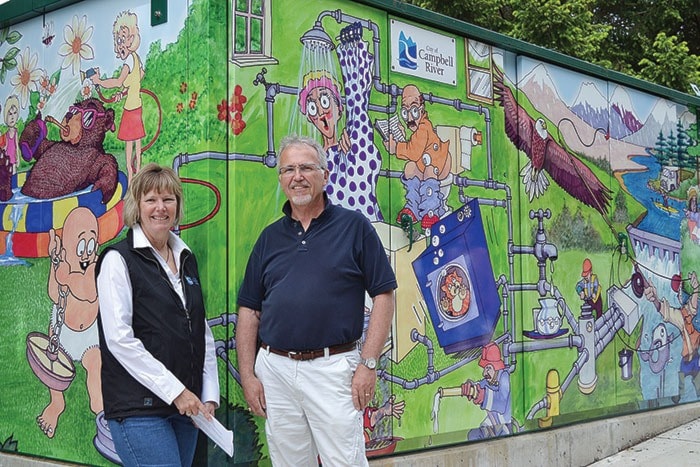It didn’t take long for taggers to put their mark on a brand-new utility box near the corner of South Alder and Rockland; so the city came up with a creative solution to deter vandalism while educating the public at the same time.
Using the artistic genius of Campbell River resident Peter Davies, the city dressed the box in a colourful wrap which illustrates the journey of the city’s drinking water.
Acting Mayor Coun. Mary Storry presented the box to city staff and members of the media Wednesday afternoon, while proclaiming May 20-26 as Drinking Water Week in Campbell River.
“We are pleased to recognize Drinking Water Week with the new artwork on this water utility box, which houses mechanical parts to keep the city’s water supply system working,” Storry said. “We’re so lucky to have our high quality of water in Campbell River. It’s important to know about our water source, and how our activities can affect water quality. It is essential that we learn what we can do personally to ensure that the high water quality we enjoy today is protected for the future.”
Davies, an illustrator, cartoonist, designer and author originally from the UK, is also known as Pete the Pen. He explained how the box animates the journey water takes on its way from the watershed to our taps.
“It starts with the watershed and the rain and snow on the mountain that runs down to the rivers, then through the dam and channeled into the city’s system and it demonstrates the way in which the community uses water – drinking water, sprinklers, fire services,” Davies said.
Comedic illustrations show a bear taking a bath in a plastic swimming pool, and a play on the pun ‘throw the baby out with the bath water’ in a graphic that shows an over-sized baby yanking out a large plug holding back the water flowing out of a fire hydrant.
“The large canvas created the perfect opportunity to create something that is both fun and educational,” Davies said. “The artwork was done as a smaller size, the product was blown up on a computer and printed as a wrap which makes it easier to clean and keep protected.
“If it’s damaged it can be replaced without the artist having to do it again.”
While the outside of the box is colourful and humorous, inside things are more complex.
The box holds two pressure regulating valves and a strainer so that if any contaminants leak in, they’re sifted out before the water goes into the valves.
The valves – and the utility box which holds them – have replaced an old asbestos concrete mix water main that broke last Christmas.
The leak caused part of the asphalt near the lights at South Alder and Rockland to crumble, creating a large hole in the road.
The leak was the result of a hole in the water pipe caused by a faulty construction piece used by a contracted company.
Water facts
- B.C. residents use an average of 353 litres of water per day but most think they use less than 200 litres.
- Twenty-six per cent of Canadians have no idea where the water that flows out of their tap comes from.
- Our domestic water consumption can increase up to 50 per cent in the summer months when people are watering their lawns and gardens.
- Only 27 per cent of British Columbians say they don’t use their toilet as a convenient garbage bin. Hair, food and dead pests are the most common items being flushed.
- Only four in 10 Canadians make the connection between water and electricity, understanding that it requires energy to treat and pump water.
- Sixty-five per cent of all indoor water use occurs in the bathroom. The next highest area of use is laundry, which accounts for 20 per cent, followed by kitchen and drinking (10 per cent) and cleaning (five per cent).
- Only 13 per cent of British Columbians think there should be major investment now in water treatment, delivery and storm water management systems in their community. Eighty-six per cent think that we only need minor regular investments for upkeep.
